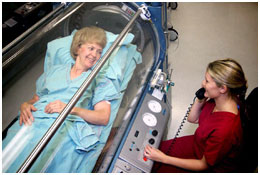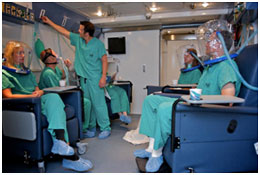About HBO2
The Undersea and Hyperbaric Medical Society defines hyperbaric oxygen (HBO2) as an intervention in which an individual breathes near 100 percent oxygen intermittently while inside a hyperbaric chamber that is pressurized to greater than sea level pressure (1 atmosphere absolute, or ATA). For clinical purposes, the pressure must equal or exceed 1.4 ATA while breathing near 100 percent oxygen. The United States Pharmacopoeia and Compressed Gas Association Grade A specify medical grade oxygen to be not less than 99.0 percent by volume, and the National Fire Protection Association specifies United States Pharmacopoeia medical grade oxygen. There is some compelling anecdotal evidence to suggest that this may be beneficial in the treatment of acute and chronic symptoms associated with traumatic brain injury. Stronger evidence including sham-controlled, randomized trials must be obtained prior to determine if hyperbaric oxygen should be used as a treatment for traumatic brain injury.


Hyperbaric oxygen can be delivered inside monoplace (single-person) or multiplace (multi-person) hyperbaric chambers. In a monoplace chamber, the entire chamber is pressurized with 100 percent oxygen and the patient breathes the chamber oxygen directly. A multiplace chamber is pressurized with regular air, and the patient breathes 100 percent oxygen by facemask or clear plastic hood.
A typical HBO2 treatment (for problems other than mild TBI) uses 2-3 atmospheres absolute pressure for 90-120 minutes. The total number of treatments per patient and the time between treatments vary widely depending on what condition is being treated.
What does HBO2 do?
Hyperbaric oxygen has many different effects on the human body. By increasing the oxygen in blood and body tissues, HBO2 helps new blood vessels and bone to grow and some wounds to heal. Whether HBO2 might help heal brain tissue is unknown.
There are currently fourteen (14) indications approved by the UHMS and they are;
- Air or Gas Embolism
- Carbon Monoxide and Cyanide Poisoning
- Clostridial Myositis and Myonecrosis (Gas Gangrene)
- Crush Injury, Compartment Syndrome and Other Acute Traumatic Ischemias
- Decompression Sickness
- Arterial Inefficiencies: Central Retinal Artery Occlusion and Enhancement of Healing In Selected Problem Wounds
- Severe Anemia
- Intracranial Abscess
- Necrotizing Soft Tissue Infections
- Osteomyelitis (Refractory)
- Delayed Radiation Injury (Soft Tissue and Bony Necrosis)
- Compromised Grafts and Flaps
- Acute Thermal Burn Injury
- Idiopathic Sudden Sensorineural Hearing Loss













